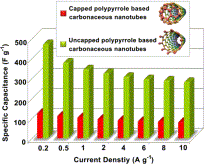Chengxin Guoa, Na Lia, Liangliang Jia, Yaowen Lia, Xiaoming Yanga,*(杨晓明), Yun Lub,* , Yingfeng Tua*(屠迎锋)
a Jiangsu Key Laboratory of Advanced Functional Polymer Design and Application, College of Chemistry, Chemical Engineering and Materials Science, Soochow University, Suzhou 215123, PR China
b Department of Polymer Science and Engineering, State Key Laboratory of Coordination Chemistry, School of Chemistry and Chemical Engineering, Nanjing University, Nanjing 210093, PR China
J. Power Sources 2014, 247, 660–666.
By the reactive self-degraded template-directed synthesis and further carbonization, N- and O-doped carbonaceous nanotubes from conducting polymer (polypyrrole) precursor have been prepared. After being chemically activated by KOH, specially, with the weight ratio of KOH to polypyrrole nanotubes of 2 and 4, two samples of activated carbonaceous polypyrrole nanotubes (ACPN-2 and ACPN-4) with an uncapped morphology were obtained. The ACPN-4 possesses high heteroatom content (14.85%) and specific surface area (1226 m2 g−1), and exhibits a reversible capacitance of 470 F g−1 at the current density of 0.2 A g−1, and 280 F g−1 even at a higher current density of 10 A g−1. Moreover, these nanotubular structured materials have also shown excellent cycling performance with no capacitance loss over 10,000 cycles. Furthermore, these carbonaceous nanotubes achieved a high CO2 adsorption uptake of 3.9 mmol g−1 at 273 K and 2.5 mmol g−1 at 298 K.

链接:
//www.sciencedirect.com/science/article/pii/S037877531301505X